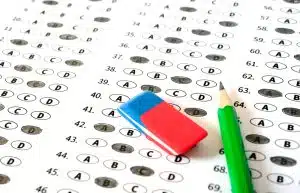If you’re taking a Spanish class, chances are you’ll encounter the National Spanish Exam (NSE) during the school year. It’s likely your teacher has already signed up for your class! Designed for students in Grades 6 through 12, this online standardized exam assesses Spanish language proficiency.
While it might seem like just another test, it’s actually the most popular Spanish test in the United States. In Spring 2019, over 150,000 students took the NSE. That’s quite a crowd! The exam focuses on measuring your skills in Spanish grammar and comprehension.
The NSE also serves as a resource for teachers, providing tools to help in teaching vocabulary, grammar, reading, and listening comprehension. Besides assessing skills, the exam offers awards and scholarships. Both students and the teachers administering the test are eligible for these rewards, which include cash scholarships.
Now that you understand the significance of the NSE, you might wonder how you can excel in it. We’re here to help with insights on the exam’s history, preparation strategies, and information on potential prizes. This knowledge can empower you to prepare and excel in your upcoming test!
When is the National Spanish Exam?
The National Spanish Exam for 2024 is scheduled between March 4, 2024, and April 15, 2024. Registration for the NSE 2024 opened on November 1, 2023, and closed on February 9, 2024. Make sure you mark these dates in your calendar if you’re planning to participate!
The History of the National Spanish Exam
The exams are administered in an online format, but that wasn’t always the case. From the years 1957 to 2005, students had to take the National Spanish Examinations in a pencil and paper format. Those days are long gone with the advancement of technology.
In 2006, the test premiered its online format for the first time through the Quia Corporation and was the first national world language exam administered online. There is a new series of exams called the National Spanish Assessments (NSA), which is the non-contest version of the NSE. The NSA, however, doesn’t have prizes or scholarships.
Since the NSE was created to test Spanish as a second language, native Spanish speakers are not eligible to take the National Spanish Examinations. If a student grew up in a home where Spanish was spoken or if the student is bilingual to some degree in both Spanish and English, they are considered a Spanish speaker. A native Spanish speaker includes:
- A student has lived (after age 6) in a Spanish-speaking country for more than a year.
- A student has studied in a Spanish-speaking country for more than 4 months.
- A student whose principal language at home is Spanish or Spanish/English.
- A student whose principal language outside the home is Spanish or Spanish/English.
Registration for the National Spanish Exam
In order to take the test, your teacher must register you online. You must be currently enrolled in their class. The thing to remember about the exams is that they won’t correspond with a teacher’s exact course or lessons. Instead, they point to a particular proficiency level of your class. For example, if you are in a novice Spanish-speaking class then your teacher would likely register for the Level 1 exam. If you’re in an advanced class your teacher might register you for Level 5 or Level 6. It’s up to your teacher. Make sure to ask your teacher to register online because there are two options for exams that you can choose from:
1. All-Level Proficiency Exam: The All-Level Proficiency Exam gives the teacher the option to predict a particular level of proficiency between Intermediate Low and Advanced High. This type of test is a great option for students who are more advanced (Advanced Spanish III, Spanish IV, and above.)
2. Specific Level Exams: The Specific Level Exams allow students to work on a specific area by providing data on their outcomes. This might include making inferences and identifying the main idea of a text.
Cost
What is the cost? There are two compulsory fees associated with the National Spanish Examinations and that is (1) the cost per teacher and (2) the cost per student. According to the National Spanish Exam website, each school pays a fee per examination to the national office that includes a national portion of $4.00 as well as an optional chapter portion (between $0.25 and $3.00 per student).
For teachers, check with your local chapter for more information on the current costs and fees associated with testing your students. There are varying chapters and coordinators depending on your state. Some states have several chapters including California, Illinois, New York, Pennsylvania, and Texas. Take some time to identify your local chapter and the fees involved.
Preparing for the National Spanish Exam
The National Spanish Exam is recognized by teaching organizations and associations at a range of local, state, and national levels, including the National Association of Secondary School Principals. This exam can make all the difference, especially if you want to major in Spanish at university. Even if you don’t want to major in Spanish, scoring well looks excellent on your college admissions. As the world’s premier Ivy League admissions consulting company with the highest acceptance rates in the industry, we know a thing or two about college admissions. It doesn’t hurt to get ready and equip yourself.
Your teacher will usually run practice exams prior to the actual test. It is recommended that students use the Online Practice Exercises throughout the school year in order to improve concepts such as interpretive communication when it comes to reading and listening to Spanish. Teachers use the National Spanish Exam as a tool to prepare students for other standardized tests and college placement exams. If you do well on the NSE, you can apply those same studying techniques for other exams such as AP or SAT tests, and into your college admissions process.
Taking a practice test helps lower the risk of having problems on the actual test day, such as a technical issue with the computer or test. Ask the teacher to allow time for the students to complete the Online Practice Examination from last year’s exam.
Online Past Examinations
Worried about the test? Don’t fret too hard. You can access Online Past Examinations and Online Practice Exams for all levels (Level 01 through Level 6), including practice exams relating to Achievement (Vocabulary and Grammar) and Proficiency (Reading and Listening). You can even print it out!
If you are struggling with Spanish or particularly worried about your results, taking the practice exam can prove very beneficial. It helps you get a sense of how the actual test will flow as well as how the questions are structured. There are multiple-choice questions, fill-in-the-blank grammar, and typing in the correct answer in the blank space provided.
To get a feel of what you’re up against, you can even look at previous National Spanish Examination average scores by category. The categories include vocabulary, grammar, reading comprehension, listening comprehension, achievement, and proficiency. The results also show how many people took the test for that year. This information is useful to see how many students took your test in a given year as well as the average result for students. This average is calculated based on the scores and the number of students tested for a particular grade, 6th through 12th. Once you take the test and get the results, you can look at the data to see how you scored in relation to others in your grade. This information can be helpful in your college admissions process.
After the Exam
Once the exam closes, teachers receive a range of reports via email. The Percentile Report for Individual Measurement Categories itemizes the raw scores and the student percentile. The Percentage Report for Learner Outcomes in Interpretive Communication lists the student percentages for specific learner outcomes. The Student Report Cards are individual documents for each student with raw scores as well as national percentile rankings. The percentiles can break down whether students qualify for a prize or scholarship, or not.
Due to privacy regulations, the reports are only sent to the teacher who administered the NSE to their students. Students will not be sent their itemized report, but you can ask your teacher to download a certificate for you to print out.
Prizes
It doesn’t hurt to have a little reward after a test. Back in elementary school that might have meant a fun pizza party with the class, but in high school, the prizes are a bit more useful. Student prizes range from national recognition to scholarships.
The National Spanish Exam offers Global Citizen Scholarships for 8th, 9th, and 10th-grade students. For 11th-grade students, NSE offers the Junior Study Abroad Scholarship which allows eligible students to travel to a Spanish-speaking country so they can study the language and the culture in an immersive experience. Students take 90-minute classes and then experience a cultural excursion to reinforce the lesson. This immersive experience looks great on your Ivy League admissions. There are a variety of excellent scholarships for high school seniors.
Students who receive exceptional scores on their exams get national recognition. Students scoring at or above the 95th percentile are called Premio de Oro. The other percentiles are recognized as Premio de Plata, Premio de Bronce, and Mención Honorífica.
Senior Scholarships are eligible for high school seniors who score above the 75th percentile (Premio de Bronce and above). Some local chapters offer awards to their winners, so check with your local chapter or coordinator for current prize structures. The previous award and scholarship winners of the National Spanish Exam have gone on to some distinguished schools across the United States and the world.
Final Thoughts
The National Spanish Exam rigorously tests students’ abilities in Spanish grammar, reading and listening comprehension, and vocabulary. While the exam may present challenges, thorough preparation can significantly enhance your performance. It is highly encouraged that students should make the most of the Online Practice Exams available for all levels, as they not only help familiarize with the exam format but also help mitigate any technological issues. As for students, with diligent practice, you are setting yourself up for success on the exam and positioning yourself as a strong contender for an award. Approach the exam with confidence—your hard work can lead to outstanding results!
Frequently Asked Questions
1. What is the National Spanish Exam (NSE)?
The National Spanish Exam is an online standardized test designed to assess the Spanish language proficiency of students in Grades 6 through 12. It is the most popular Spanish test in the United States, focusing on grammar, vocabulary, reading, and listening comprehension. The NSE also offers various awards and scholarships to both students and teachers who administer the test.
2. Who is eligible to take the National Spanish Exam?
The NSE is intended for students learning Spanish as a second language. Native Spanish speakers or students who have significant exposure to Spanish at home or through extended stays in Spanish-speaking countries may not be eligible. Specific criteria include having lived in a Spanish-speaking country for more than a year after age 6, or having Spanish as a principal language at home or outside the home.
3. How can I register for the NSE, and what are the costs involved?
Registration for the NSE must be completed by your teacher, who will enroll students based on their proficiency levels. Costs vary by location and include a national fee and an optional chapter fee. Teachers should consult their local chapter for detailed fee information and registration procedures.
4. What types of exams are offered through the NSE?
The NSE offers two main types of exams: the All-Level Proficiency Exam and Specific Level Exams. The All-Level Exam allows teachers to predict a proficiency level from Intermediate Low to Advanced High, while Specific Level Exams provide detailed feedback on student performance in particular areas, such as vocabulary, grammar, reading, and listening comprehension.
5. How should I prepare for the National Spanish Exam?
Preparation for the NSE should include regular practice using the Online Practice Exams available for all levels. These practice sessions help students familiarize themselves with the exam format and address potential technical issues. Reviewing past examinations and understanding the average scores in various categories can provide insights into the expected difficulty and content of the exam.









































